On-site conversions are often secondary goals, afterthoughts of the paid search funnel.
“96% of the time, people click on these ads and do not perform the action that marketers desired them to do,” says Wordstream co-founder and CTO, Larry Kim, in the eBook Optimizing Your Conversion Engine: Search Engine Marketing. “They visit the site and don’t convert to a lead or a sale.”
A lot of people click ads from search, but the vast majority of those people don’t convert into customers/downloads/sign ups—or whatever the goal is. This may seem counterintuitive because if click-through rate is high, then views on the landing page will be high, too. Shouldn’t conversions follow suit?
4 Easy Landing Page Improvements to Increase Paid Conversions by @CaraHarshman
Unfortunately, this is not the case—and it points to a missed opportunity for your business. After all, you paid for these people to visit your site.
Most landing pages are poorly designed to convert paid traffic, or they’re non-existent. Many marketers send paid traffic to the homepage or pages on the website without clear calls to action.
By optimizing pages for paid marketing traffic, you’ll get a much better return on your investment in ad spend. Let’s look at best practices for improving the performance of your on-site experience for paid traffic.
1. Send Traffic to the Right Page
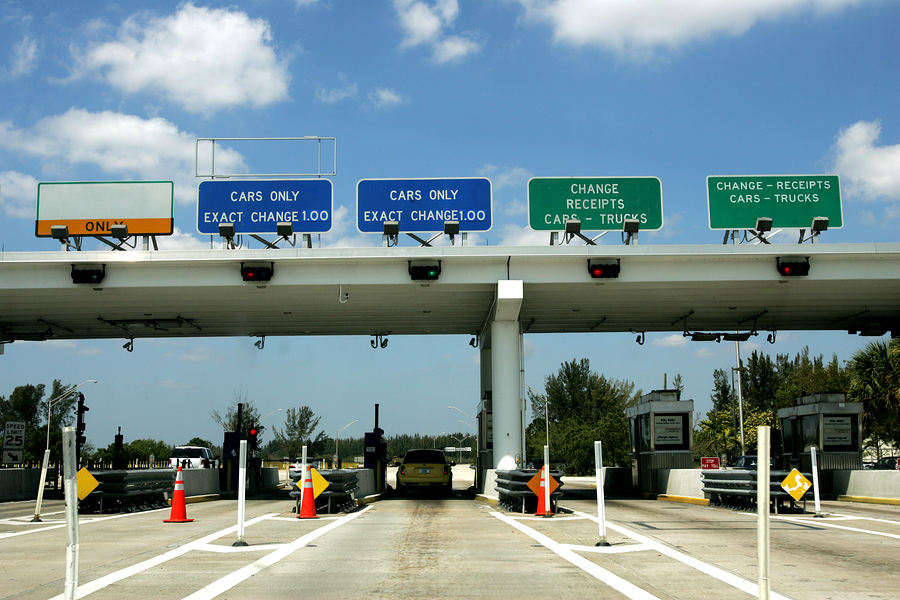
Sending paid traffic to the right landing page is like sending cars through a toll booth.
Not all vehicles go through the same line—they are segmented by payment type and type of vehicle. Sending all traffic through one vestibule would be incredibly inefficient and people would have a more frustrating experience.
The same principles apply to landing pages. Not all traffic should be directed to the same landing page. Each page should be topic-focused and highly relevant to the ad someone clicked to get there.
Yes, this means you need more than one landing page.
You should have various landing pages according to specific segments. A segment is a group defined by a specific set of attributes. When it comes to paid traffic, referral source—also known as channel—is an important attribute to track. If you are promoting a piece of content for download on Twitter, LinkedIn, and Google Display, the user experience will be different on each channel. To increase conversion rates, match the messaging on the landing page to a visitor’s referral source. And be sure to monitor how these different segments perform, which will inform strategy moving forward.
2. Be Consistent in Your Messaging from Referral Source to Landing Page
We learned this lesson the hard way. Our teachable moment came from a webinar invite email. (While it’s not an example of an ad, this example paints a pretty clear picture.)
We sent an email to a list of leads and customers promoting a webinar. The headline we chose in the email was “5 Steps to Running More Successful Experiments.” When people clicked the shiny, “Save My Spot” call to action button, they saw a landing page with headline, “5 Steps to Your First Meaningful A/B Testing Win.”
Conversions on the page didn’t take a huge hit, but a few people emailed us directly, confused if they were signing up for the right thing.
The big takeaway here is that if you set an expectation, you need to meet it. Make it easy for people to know they’re in the right place.
If you set an expectation, you need to meet it.
When it comes to PPC, this lesson is even more important because you’re paying per click. Jeff Lane is a PPC guru who has managed online advertising for political campaigns and large health organizations. He advises incorporating ad text into the landing page copy for consistency.
“Try dynamically incorporating some or all of your ad text in your landing page copy,” Jeff says. “The continuity of messaging can go a long way towards reassuring visitors that they’ve reached the right place. And, if that localization or other relevant messaging helped drive that visit, inclusion of the copy will feed off of the reason the user clicked in the first place. You are keeping that user engaged.”
3. Experiment with the Order of Your Calls to Action
When I say experiment with your calls to action, I don’t mean test the button color or copy on the page. Those are great tests too, but we’re going to get a bit more advanced. Test the order of actions you ask people to take.
As an example, if your conversion goal from a PPC campaign is sign-ups for a free trial, run a test that varies the order in which you ask for the information necessary to start a free trial: name, email, and credit card information.
In the matrix below, we show possible page flows for a software as a service (SaaS) company whose primary conversion goal is free trial sign-ups. Signing up for a free trial form requires entering credit card information and picking a usage plan.
Each variation starts with a hypothesis about why the new flow will increase conversions.
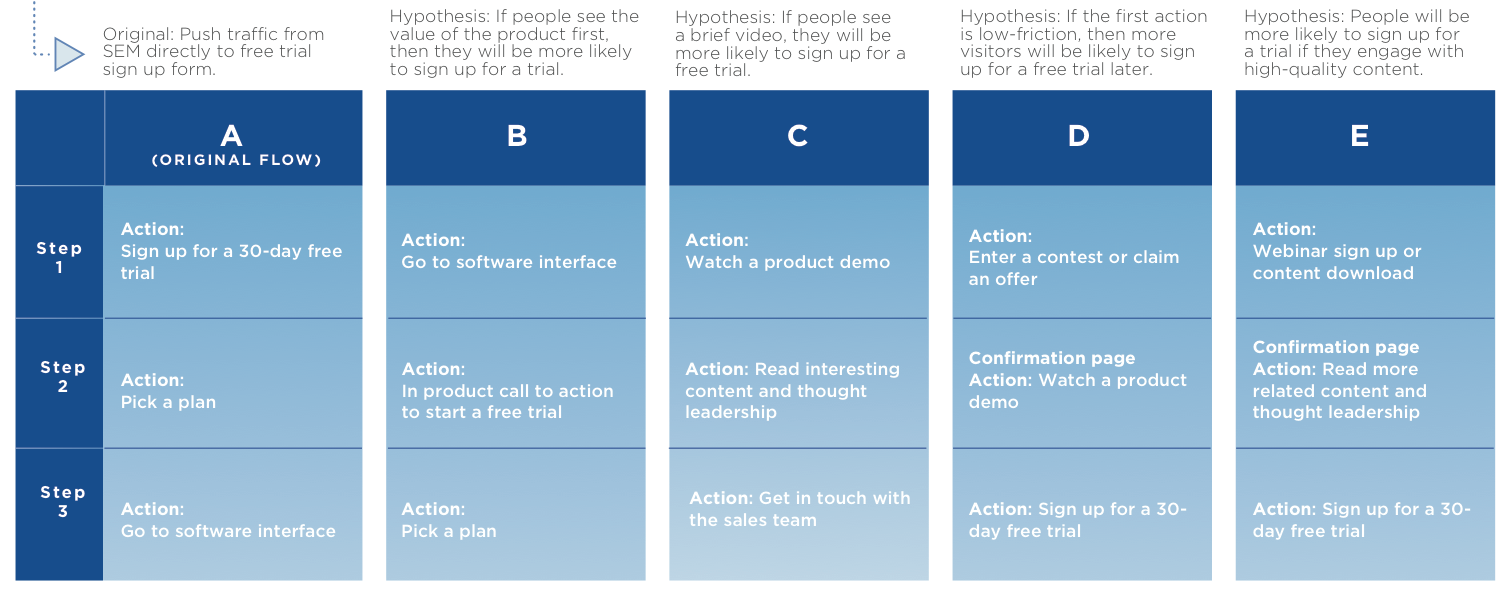
Forms are an easy way to test user flow because you can break them into many parts and experiment with which part comes first. Consider this example from the Obama 2012 campaign.
Kyle Rush, now the Head of Optimization at Optimizely, used to run A/B testing on the Obama 2012 campaign. He learned a great lesson from testing the order of operations in a donation form.
It was June of 2012, a couple months before the November election, and the site was hyper-optimized. Every element had been scrutinized and tested with many variations. Still, testing continued and the page in question was the donation form.
They hypothesized that splitting the form into multiple steps would increase conversion rates. Their hypothesis: You can get more people to the top of the mountain if you show them an incline instead of a steep slope. So instead of showing one long form with many fields, Kyle set up an A/B test that led people through a funnel with smaller steps. They called this variation “Sequential.”
By turning a long donation form into 4 smaller steps, Kyle’s team increased the donation rate by more than 5%.
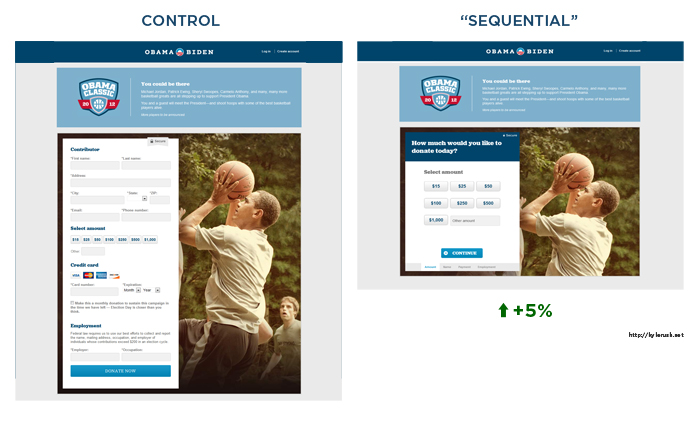
They wanted to avoid overwhelming people with simple steps, then ease them into filling out the trickier fields like credit card information. Like this example shows, changing the order and/or presentation of actions you want people to take is a huge opportunity to rethink your funnel and uncover significant conversion strategies.
4. Don’t Send Paid Traffic to the Homepage
Sending paid traffic to the homepage is a lost conversion opportunity—guaranteed. Most homepages aren’t specific enough to the information the person was searching for. Also, the homepage is usually rife with information and options. People who land here from an ad don’t know what to click.
If you are sending paid traffic here, ask yourself, “Is my main conversion goal obvious and easy to achieve from the homepage?”
Sending paid traffic to the homepage is a lost conversion opportunity—guaranteed.
If it is, then the homepage may be an okay place to send traffic. If it’s not, start creating dedicated landing pages.
Let’s use Zappos as an example. I search “winter boots” in Google and see a few ads come up.
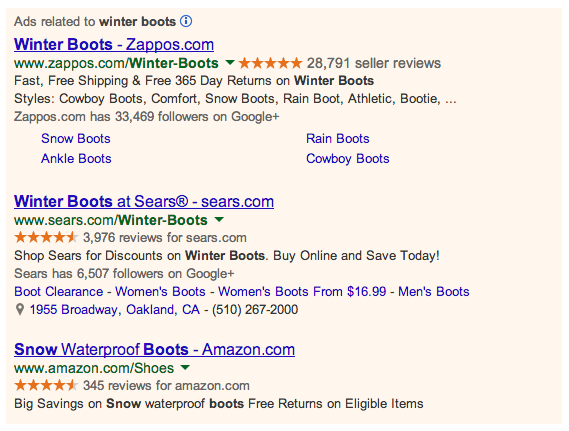
I click one for Zappos and land on a category page for boots, and here’s how I feel…
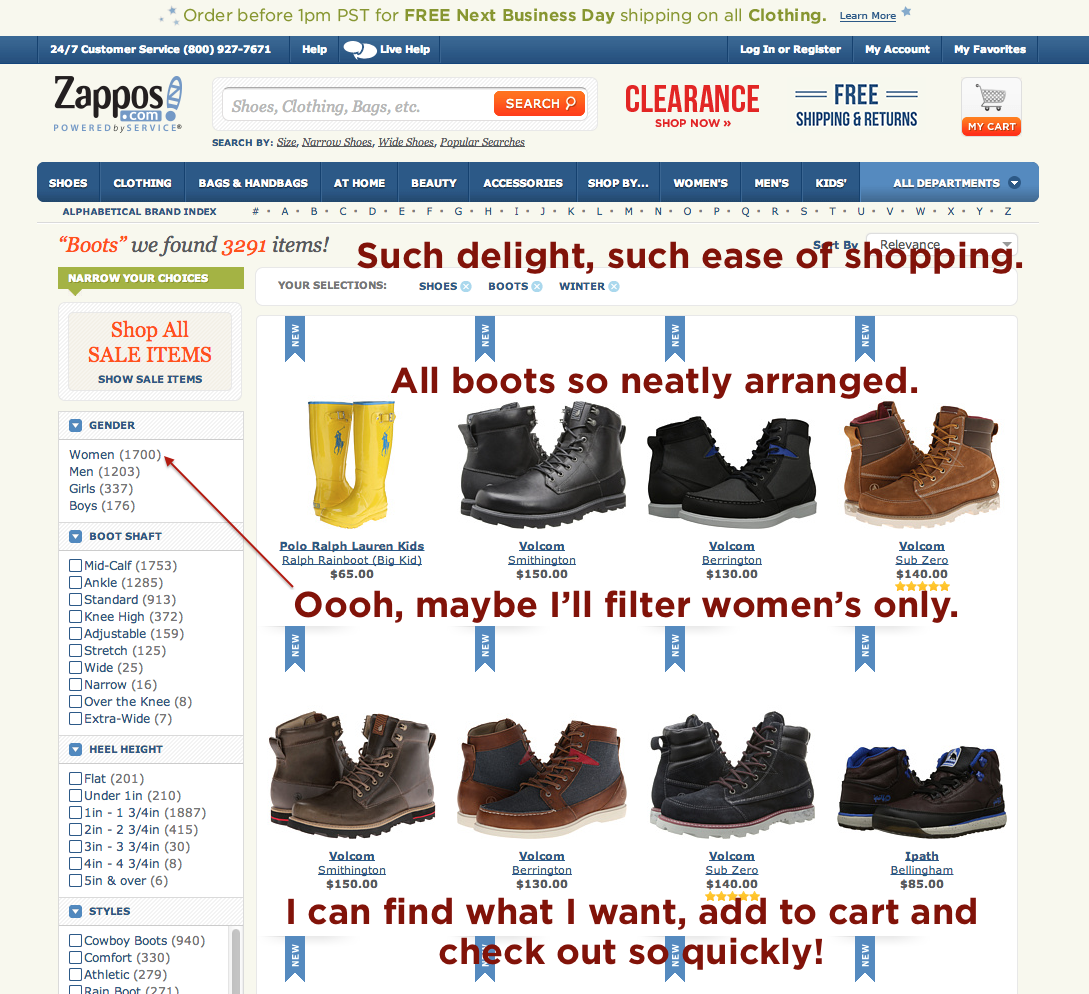
If I had clicked it and landed on the homepage, this is how I would feel…
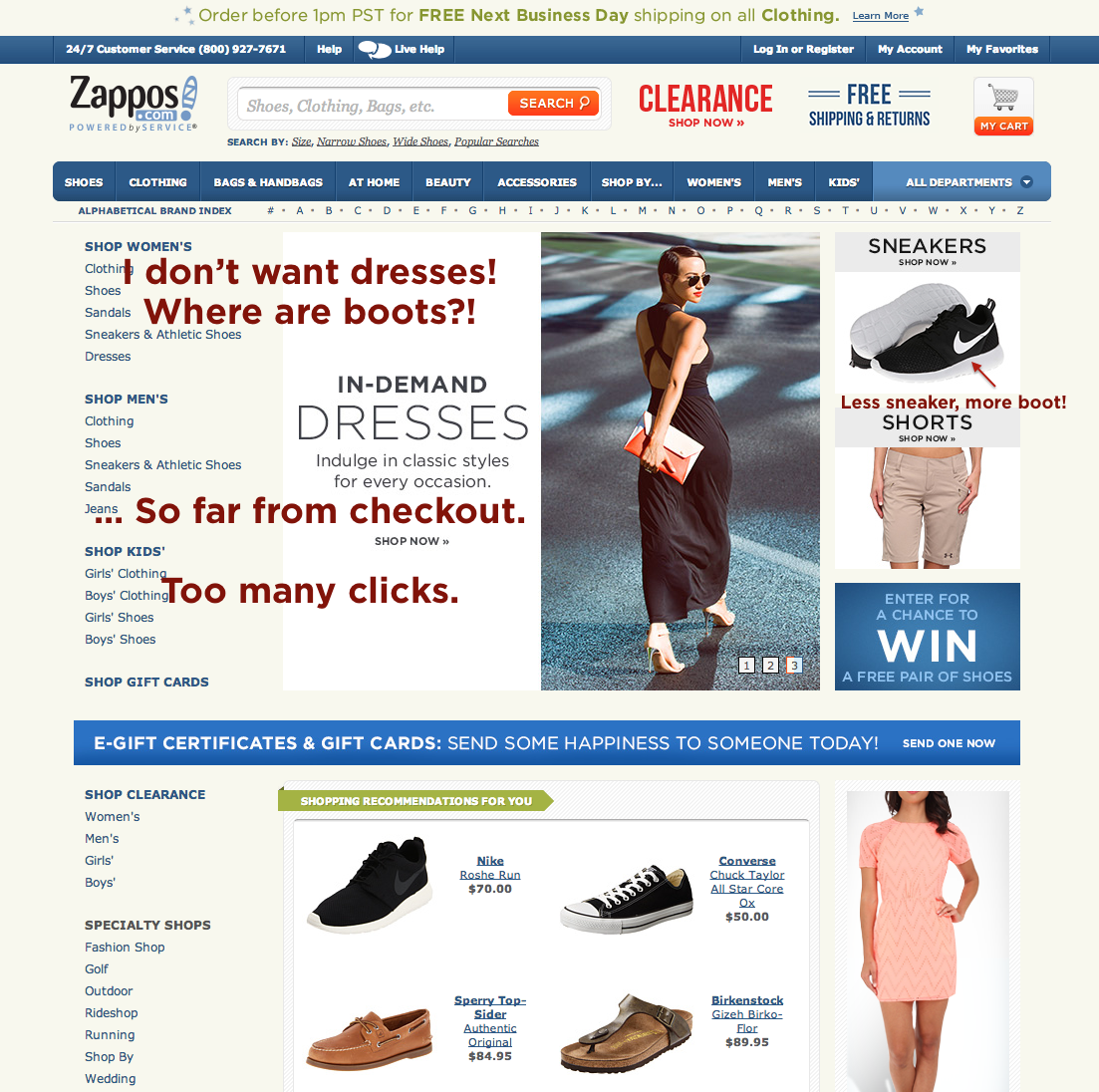
Don’t waste clicks and money. Send your paid traffic to landing pages.
Again…Why Is Testing Landing Pages so Great?
Discovering one big win on a single landing page can increase conversion rates by an order of magnitude because of a very special trait of landing pages: they are commonly templatized. Most companies use landing pages with similar designs for a number of keywords. The main difference between them will be the messaging. You want the messaging to be as relevant as possible to the search term. If you uncover a conversion win on one landing page, you can immediately test it across the others and start seeing an increase in conversions. And more conversions means more ROI for you.
To learn more about more testing ideas for paid traffic, and how optimization can help you get a lot more ROI out of search engine marketing, download this in-depth guide to conversion optimization for SEM.
